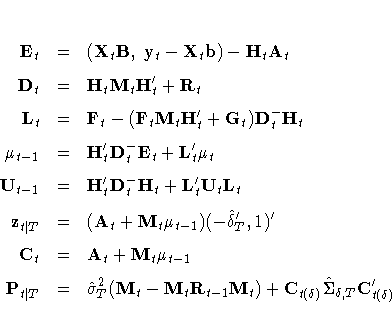KALDFS Call
- CALL KALDFS( sm, vsm, data, int, coef, var, bvec,
bmat, initial, at,
- mt, s2 <, un, vun>);
KALDFS computes the smoothed state vector and its
mean square error matrix from the one-step forecast
and mean square error matrix computed by KALDFF.
The inputs to the KALDFS subroutine are as follows:
- data
- is a T ×Ny matrix containing
data (y1, ... , yT)'.
- int
- is an
 vector for a time-invariant
intercept, or a
vector for a time-invariant
intercept, or a  vector containing fixed matrices for the time-variant
model in the transition equation and the measurement equation,
that is, (W't, X't)'.
vector containing fixed matrices for the time-variant
model in the transition equation and the measurement equation,
that is, (W't, X't)'.
- coef
- is an (Ny + Nz) ×Nz matrix for a time-invariant
coefficient, or a (T + lead)(Ny + Nz) ×Nz matrix containing coefficients at each time
in the transition equation and the measurement equation,
that is, (F't, H't)'.
- var
- is an (Ny + Nz) ×(Ny + Nz) matrix for a
time-invariant variance matrix for transition equation
noise and the measurement equation noise, or a
(T + lead)(Ny + Nz) ×(Ny + Nz)
matrix containing covariance matrices for the transition
equation and measurement equation errors, that is,
 .
.
- bvec
- is an
 constant vector for
the intercept for the mean effect
constant vector for
the intercept for the mean effect  .
.
- bmat
- is an
 matrix for
the coefficient for the mean effect
matrix for
the coefficient for the mean effect  .
.
- initial
- is an
 matrix containing an
initial random vector estimate and its covariance matrix,
that is,
matrix containing an
initial random vector estimate and its covariance matrix,
that is,  .
.
- at
- is a
 matrix containing
(A'1, ... , A'T)'.
matrix containing
(A'1, ... , A'T)'.
- mt
- is a (TNz) ×Nz matrix containing
(M1, ... , MT)'.
- s2
- is the estimated variance in the end
of the data set,
 .
.
- un
- is an optional
 matrix containing
matrix containing  .
The returned value is
.
The returned value is  .
.
- vun
- is an optional Nz ×Nz matrix containing UT.
The returned value is U0.
The KALDFS call returns the following values:
- sm
- is a T ×Nz matrix containing smoothed state
vectors
 .
.
- vsm
- is a TNz ×Nz matrix containing mean
square error matrices of smoothed state vectors
 .
.
Given the one-step forecast and mean square error
matrix in the KALDFF call, the KALDFS call computes a
smoothed state vector and its mean square error matrix.
Then the KALDFS subroutine produces an estimate of the
smoothed state vector at time t, that is, the conditional
expectation of the state vector zt given all observations.
Using the notations and results from the KALDFF
section, the backward recursion algorithm for
smoothing is denoted for t = T, T-1, ... , 1,

where the initial values are  and UT = 0, and
and UT = 0, and  is
the last-column-deleted submatrix of Ct.
Refer to De Jong (1991b) for details on
smoothing in the diffuse Kalman filter.
is
the last-column-deleted submatrix of Ct.
Refer to De Jong (1991b) for details on
smoothing in the diffuse Kalman filter.
The KALDFS call is accompanied by the
KALDFF call as shown in the following code:
ny = ncol(y);
nz = ncol(coef);
nb = ncol(int);
nd = ncol(coefd);
at = j(nz,nd+1,.);
mt = j(nz,nz,.);
qt = j(nd+1,nd+1,.);
n0 = -1;
call kaldff(pred,vpred,initial,s2,y,0,int,coef,var,intd,coefd,
n0,at,mt,qt);
bvec = intd[nz+1:nz+nb,];
bmat = coefd[nz+1:nz+nb,];
call kaldfs(sm,vsm,x,int,coef,var,bvec,bmat,initial,at,mt,s2);
You can also compute the smoothed estimate and
its covariance matrix observation by observation.
When the SSM is time invariant, the
following code performs smoothing.
You should initialize UN and VUN as matrices of value 0.
n = nrow(y);
ny = ncol(y);
nz = ncol(coef);
nb = ncol(int);
nd = ncol(coefd);
at = j(nz,nd+1,.);
mt = j(nz,nz,.);
qt = j(nd+1,nd+1,.);
n0 = -1;
call kaldff(pred,vpred,initial,s2,y,0,int,coef,var,intd,coefd,
n0,at,mt,qt);
bvec = intd[nz+1:nz+nb,];
bmat = coefd[nz+1:nz+nb,];
un = j(nz,nd+1,0);
vun = j(nz,nz,0);
do i = 1 to n;
call kaldfs(sm_i,vsm_i,y[n-i+1],int,coef,var,bvec,bmat,
initial,at,mt,s2,un,vun);
sm = sm_i // sm;
vsm = vsm_i // vsm;
end;
Copyright © 1999 by SAS Institute Inc., Cary, NC, USA. All rights reserved.
